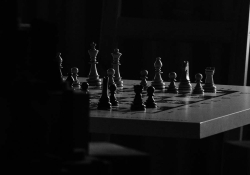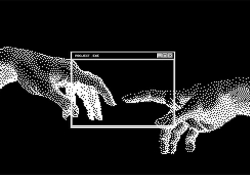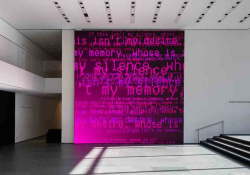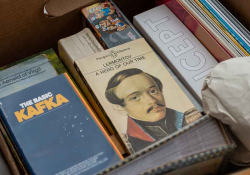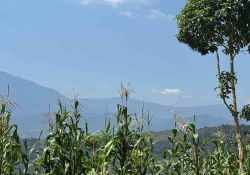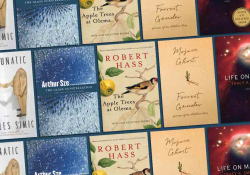Wheels of Fire: Writers on Bicycles
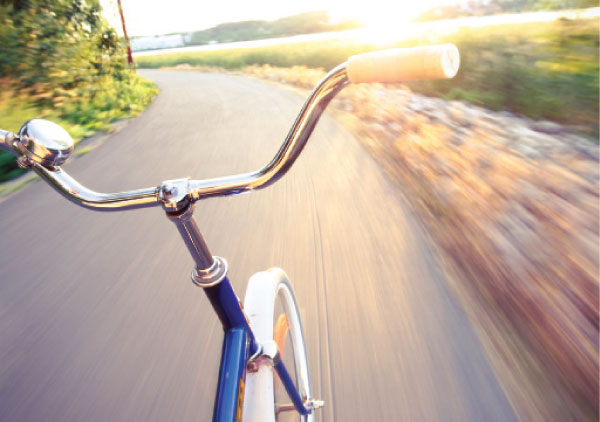
Under the sign of the bicycle, writers and riders share a special affinity. Alon Raab offers a global literary tour.
Bicycles: because love requires trust and balance. – Nikki Giovanni
In the beginning was the bicycle wheel and it went swish, swish, swish . . .
It is a cool autumn morning and I am riding downhill. The wind is blowing across my face, the air is crisp, the light filters through the trees. I am gliding fast, past houses and cars. My legs and lungs are powering me forward, and I feel a loving sense of movement. Some people’s lives are lived under the sign of the computer, telephone, or stock exchange. My life has always been connected with that most simple invention, the bicycle.
Bells, sprockets, tires, dynamo lights, spokes, and the strong spaces between the spokes. I was still a toddler when my parents gave me a shiny red tricycle and six years old when a beautiful “Flying Camel” green bicycle, adorned with a silver decal bearing its namesake, appeared by my side. Since then I have felt a deep love toward bicycles and an appreciation of their generosity, ferrying me without complaint or squeak to play, school, work, friends, and my beloved. This gratitude was shared also by Albert Einstein—who reportedly discovered the theory of relativity while on a bicycle—and by the legions of writers who have sailed upon a bi-cycle and sung its praises. “The bicycle, the bicycle surely, should always be the vehicle of novelists and poets,” proclaimed journalist and essayist Christopher Morley in his 1917 collection Parnassus on Wheels, and indeed a team of bicycle enthusiasts would be worthy of winning any Tour de Literature contest. Leo Tolstoy, Alfred Jarry, Yevgeny Yevtushenko, Aldous Huxley, Bruno Schulz, Lu Xun, Simone de Beauvoir, Samuel Beckett, Naguib Mahfouz, Alain Robbe-Grillet, Henry Miller, Edward Gorey, Astrid Lindgren, William Saroyan, R. K. Narayan, Ernest Hemingway, Vladimir Nabokov, Chinua Achebe, Alan Sillitoe, Iris Murdoch, Rita Dove, William Stafford, and Seamus Heaney are but some of its luminaries. Writers from every continent have paid homage to cycling, describing the joy and sometime pain felt when mounting a machine known as a “silent steed” and a “two-wheeled dream with which to wield dreams.” These creations are a source of personal self-discovery that also illuminate larger political, social, and cultural realities.
Bicycles are a source of personal self-discovery that also illuminate larger political, social, and cultural realities.
***
The first images resembling human–powered vehicles appear on Pompeii frescos, while a 1637 stained-glass window in the St. Giles church at Stokes Poges, outside London, showcases a golden-haired cherub straddling a tricycle and blowing a horn. In 1817 Baron Karl von Drais, sitting atop a wooden machine, propelled himself uncomfortably by his feet through the German countryside in what most historians regard as the first ride. The invention was a response to the explosion of Indonesia’s Mount Tambora and the death of most European farm animals from its ash, necessitating a new mode of transport. It swiftly captured the heart of other members of the nobility and assorted dandies, who soon zoomed around cities and country terrorizing humans and animals alike. Technical innovations such as pedals, air-filled tires, and brakes improved mobility, speed, safety and comfort, and soon the working classes, too, were under its spell.
From its earliest days, many of the phenomena familiar to today’s bicycle lovers and detractors existed and were commented upon. These included riding fashions prompting mockery (late-nineteenth-century bloomers and today’s ass-hugging lycra outfits); accidents, including that of Frenchman Pierre Lallement, the first rider in the United States, whose ride down a Connecticut hill ended in a crash when he tried to avoid a cart; clashes with the police and with other modes of transport; and a trove of literature, music, and art celebrating the new invention. The bicycle appears consistently through the last two centuries, but especially at times when cycling made a leap in popularity—the end of the nineteenth century, the 1970s, and the last two decades.
While art and print representations of the bicycle and its riders existed from the beginning, the last decades of the nineteenth century and the first decades of the twentieth were a golden age for cycling songs and literature. Hundreds of songs were composed, covering everything from work to romance, leisure to politics. The most enduring of these ditties remains Harry Dacre’s “Daisy Bell.” (The song appeared in the film 2001: A Space Odyssey as Hal, the murderous computer, sings these lines while being disabled.)
Among the many early stories, George Ade’s Rollo Johnson, the Boy Inventor; or, The Demon Bicycle and Its Daring Rider, about a young racer, and John Kendricks Bangs’s “The Bicyclers,” about the cycling adventures of New Yorkers, culminating in an arrest by one of New York’s finest for riding without a lamp, stand out.
One of the most popular works of the era was satirist Jerome K. Jerome’s Three Men on the Bummel (1900). The tale of Englishmen escaping their wives and duties to journey through Germany’s Black Forest allowed Jerome to poke fun at German manners and solemnity and at British pretensions and the tendency of Britain’s representatives abroad to feel superior to the European natives.
Travel accounts through lands known and unknown captured the public’s imagination. Thomas Stevens’s Around the World on a Bicycle, Karl Kron’s Ten Thousand Miles on a Bicycle, and Joseph Pennell and Elizabeth Robins Pennell’s Two Pilgrims’ Progress were among the most popular accounts. Stevens, an Englishman, was the first person to cycle around the world, accomplishing the feat atop a high-wheeler (a Penny-farthing) from April 1884 to December 1886. The American Karl Kron rode mostly in North America but included information on rides abroad. “When the solitary wayfarer glides through the country on top of a bicycle . . . his relations to his human environment are absolutely altered,” begins Kron’s account. “[This is a] book of American roads, for men who travel on the bicycle. Its ideal is that of a gazetteer, a dictionary, a cyclopaedia, a statistical guide, a thesaurus of facts.” It is dedicated to “Curl, the Best of Bull-Dogs,” and includes, among travel descriptions, a detailed biography of his beloved animal. The following, from the Pennells’ 1886 account, gives a taste of the travel experience:
Just beyond Montelupo, when a tedious up-grade brought us to a broad plateau, a cart suddenly came out a little way in front of us from a side road. A man was driving, and on the seat behind, and facing us, were two nuns, who wore wide straw hats which flapped slowly up and down with the motion of the cart. When they saw us, the younger of the two covered her face with her hands, as if she thought us a device of the Devil.
Even in its early days, some writers refused to take the bicycle seriously, mocking the widespread mania. In “Taming the Bicycle,” Mark Twain described his experience as a series of mishaps and accidents, broken limbs, hospital stays, running over dogs, and violations of nature, but at least the bicycle remained in good shape. He concludes by advising, “Get a bicycle. You will not regret it, if you live.” Twain also included his nemesis in A Connecticut Yankee in King Arthur’s Court, but in a heroic vein, as five hundred knights on bicycles rescue the narrator and the king from certain hanging.
H. G. Wells was another devoted cyclist. He featured his favorite mode of transportation in several novels, including Wheels of Chance: A Holiday Adventure, in which it featured prominently. This 1896 yarn is the story of Mr. Hoopdriver, a down-on-his-luck drapery-store assistant who leaves all behind and ineptly rides a clunky, secondhand bicycle across England’s southern coast. Through this tale of adventure and misadventure, the socialist Wells directed sharp barbs at the upper classes and their actions.
The end of the nineteenth century was a time when women, too, hopped on bicycles, attaining greater mobility, physical health, and independence from societal constraints, prompting Susan B. Anthony to declare that the bicycle “has done more to emancipate women than anything else in the world.” Some women wrote about their newfound freedom, including Frances E. Willard, leader of the Women’s Christian Temperance Union. In her widely read A Wheel Within a Wheel, she described learning to ride at age fifty-three: “I began to feel that myself plus the bicycle equals myself plus the world, upon whose spinning wheel we must learn to ride or face into the sluiceways of oblivion and despair.” Cyclists such as Annie Londonderry Kopchovsky, who in 1894 left her Boston home and three children for a global ride, were widely written about, becoming also the subjects of poems and songs.
The emergence of the automobile dampened the public’s enthusiasm for the slower ride for a while, but throughout the years it was never forgotten. William Saroyan’s autobiographical The Bicycle Rider in Beverly Hills describes his experiences as a messenger and what he learned from riding: “I was not yet sixteen when I understood a great deal, from having ridden bicycles for so long, about style, speed, grace, purpose, value, form, integrity, health, humor, music, breathing, and finally and perhaps best, of the relationship between the beginning and the end.” For Henry Miller in My Bike and Other Friends, his brakeless one-speeder, made in Chemnitz, Saxony, was his “best friend,” a bearer of many joys.
Bicycles play many roles in individual and societal lives, including as facilitators of independence and liberation, and literature reflects these. From their earliest days, people have connected bicycles and love, bicycles and sex.
The bicycle held special appeal for continental writers as well. Simone de Beauvoir described her companion Jean-Paul Sartre as a dedicated cyclist who preferred riding to the monotony of walking, and who “would amuse himself by sprinting on the hills,” while when sailing absentmindedly on flat terrain he often landed in a ditch. The French existentialist also writes about bicycles in his tome Being and Nothingness, using them to examine the nature of possessing an object. He concluded that “handing over a bank note is enough to make a bicycle belong to me, but my entire life is needed to realize this possession.” In her wartime diary, Beauvoir described, among details of the Occupation, how she learned to ride using the bicycle of her former student and then-lover, Nathalie Sorokine. “I really handled it with ease, except one time I crashed into a dog and another time I collided with two women, and I was very happy.” On one occasion, when the two lovers went out together, Sorokine ran along beside her. After a heated argument, Sorokine grabbed her bicycle and rode away, ending the affair.
Samuel Beckett, another Paris resident, was also a cyclist. In his bleak universe, bicycles represent hope. In More Pricks Than Kicks, Belacqua Shuah, “who could on no account resist a bicycle,” withstands a young woman’s advances, hops on “a fine light machine, with red tyres and wooden rims,” and sails away. Beckett writes, “The machine was a treat to ride. . . . Belacqua’s sadness fell from him like a shift.” In Beckett’s Molloy, the protagonist, Moran, promises to write four thousand words about his metal-and-rubber steed. He sings, “Happily it went downhill. Happily I had mended my hat, or the wind would have blown it away. Happily the weather was fine and I no longer alone. Happily, happily.”
***
In the last two decades, several anthologies of bicycle literature have appeared in the United States and western Europe. While containing many excellent selections, they were mostly by American, German, French, and British male writers. Similarly, David Herlihy’s much-praised Bicycle: The History devoted only 2 of its 480 pages to China and India, nations that comprise a third of the human race and where bicycles are abundant. These omissions ignore the particular flavor and the wealth of experience of every locale.
Cycling was introduced to China by foreign sailors, merchants, and missionaries and soon adopted by the local population. In 1936 Lao She published Rickshaw Boy, the story of a young Beijing rickshaw driver, whose attempts to make a living honestly and improve his lot in life fail. The kindness of a university student-activist who stands with him against a wealthy driver and the police awakens his awareness of the bonds he shares with millions of his countrymen. With its vernacular Beijing dialect, sharp social criticism, and humanist outlook, this story of struggle is still among the most well-loved Chinese novels.
Economic hardships and the radical changes transforming Chinese society in the last two decades are explored in Zhu Wen’s satiric story “Wheels.” A minor bicycle accident and chance encounter lead to unforeseen results as thugs, well connected with corrupt local officials, shake up the narrator, a factory worker, and squeeze from him every yuan possible until he fights back. Through the focus on a bicycle, the new market economy and its devastating effects on individuals and society unfold.
The Indian subcontinent, too, has a rich cycling tradition. R. K. Narayan, one of India’s leading writers, was a lifelong rider who once peddled to schools in his hometown of Madras to beg librarians to accept the unsold copies of his early work, Swami and Friends. In The Painter of Signs (1976), the hero, Raman, uses his bicycle to carry the tools of his trade. He is content with his simple life, but everything changes when he meets the independent-minded Daisy. Hired to paint signs for the birth-control clinics she opens, his unrequited love shatters his idyllic existence.
Pakistani writers also found the bicycle a worthy subject. In his humorous 1927 story “Obituary,” leading writer and diplomat Patras Bokhari’s narrator hates cars and dreams of bombing them because of their effects on health and the social inequality they engineer. When a friend offers a bicycle he describes as a treasure, he gladly accepts but insists on paying for the gift, and hands over all his money. He imagines long, leisurely rides, “gracefully passing all the people out strolling. The dying light of the sun would bounce off the bike’s metal. The bike would shimmer and it would appear as though a crane were flying along just above the ground.” This dream turns into a nightmare, for “as soon as I started pedaling, it seemed as though a corpse, cracking its bones, was coming back to life against its will.” All sorts of sounds were emerging from different parts of the bike, with cheen-chaan-choon, khat-khar-khar-khar, and char-charkh-char-charkh but a few, startling mothers and babies. After a torturous ride, the hero decides that it is best to toss the broken bicycle in the river and goes back to his bomb plotting.
Another Urdu-language story, writer and psychiatrist Hasan Manzar’s “The Rocking Chair,” describes a series of events that unfold after teenager Yalda’s bicycle chain falls. Ibn-e Hasan, a neighborhood hoodlum, offers to overhaul the bicycle but demands a kiss. Gradually his demands increase; unable to refuse, Yalda loses her virginity and reputation. She is forced to marry her tormentor but on their wedding night manages to summon courage and leave him, despite his threats.
Among the African writers who wrote of the bicycle is Chinua Achebe, who in the novel Things Fall Apart describes a white settler riding on his bicycle in 1905 Nigeria, his murder leading to British military retaliation. And in “Civil Peace,” the protagonist uses his bicycle-taxi to make ends meet and rebuild his life after the civil war. Cameroonian Tikum Mbah Azonga’s “The Wooden Bicycle” expresses the economic hardships experienced by many of his countrymen through the story of Moses Bikwibili, whose dreams of going to college are made real thanks to a wooden bicycle he carves and rides. His father destroys it, seeing it as a waste of time, but Moses builds another one and sells it to the European owner of a shoe company, who gives it to his daughter.
Bicycles have captured the imagination of Arab writers as well. Foremost among them, Egyptian Nobel Prize–winner Naguib Mahfouz’s short-story collection The Dreams opens, “I was riding my bicycle from one place to another. Mahfouz often rode his old, beaten bicycle among Cairo’s congested streets. Ibrahim Aslan, another Egyptian author, describes a blind con man named Sheikh Hosni in The Heron, a novel set during the 1977 bread riots. Deciding to ignore his blindness, Sheikh Hosni mounts a bike and rides, but takes a wrong turn and is hurled into the Nile River. He cries for help, but as the sun had set, passersby mistake him for the river demon and, believing that he has come to take a few children, start pelting him with rocks. He recognizes one of his tormentors, but the man does not believe that he rode a bike. Only after ringing the bicycle bell is he rescued from the waters. Tunisian writer Mustafa al-Farisi offers a more bemused look at bicycles, noting in his story “Who Knows? Maybe”: “How unfeeling bicycles were! Hind began to hate them because they prevented young men from walking. What had God given people legs for?”
Writers have placed their favorite vehicle not only along terrestrial tracks but outside them as well. French writer Raymond Queneau’s The Flight of Icarus tells of the Greek youth who tires of being imprisoned in the pages of an unfinished book by a fin-de-siècle author. Desiring to experience the world in an immediate and direct way, he escapes, his means of liberation a bicycle he rides to freedom. Dylan Thomas’s unfinished screenplay, Me and My Bike, is about the life of bicycle-mad Fred. It follows him from his youth as a stable boy, through many cycling adventures, and to his ride into heaven, where a chorus of cycling angels, ringing their bells, greets him. Irishman Flann O’Brien’s surreal The Third Policeman takes place in a village where, due to constant riding on mountain roads, molecules are exchanged between humans and machines so that many villagers are half-bicycle, while many bicycles become half-human. And Jewish-Polish writer Bruno Schulz, in The Street of Crocodiles, describes the imminent end of the world, a splendid comet heralding this end, and bicyclists hurling across the heavens:
Oh, stellar arena of night, scarred by the
evolutions, spirals and leaps of
Those nimble riders; oh, cycloids and epi-
cycloids executed in inspiration
Along the diagonals of the sky, amid lost
wire spokes, hoops shed with
indifference, to reach the bright goal
denuded, with nothing but the pure
idea of cycling! From these days dates a
new constellation, the thirteenth
group of stars, included forever in the
zodiac and resplendent since
then in the firmament of our nights:
the cyclist.
***
Bicycles play many roles in individual and societal lives, including as facilitators of independence and liberation, and literature reflects these. This sense is expressed by Palestinian-American writer Lisa Suhair Majaj’s poem “Stone Fence”: “I was a small child climbing walls, defying my father’s injunctions. Who wants a tomboy for a wife? I clambered up cherry trees, skinned my knees, rode my bike farther than I was allowed to go. On picnics I collected rocks, hoarding them in the old tin can I kept under my bed. It rattled like my mother’s button box . . . I build myself up as I go” (WLT, Sept. 2004, 20–21). In Libyan Azza Kamil Al-Maghour’s “The Bicycle,” young girls ignore family directives and learn to ride, enabling them to attain some autonomy and self-worth. (This theme is also expressed in the Iranian film The Day I Became a Woman and the Yemeni documentary A Stranger in Her Own City, though the freedom gained through riding is short-lived.) Trinidadian Monique Roffey, too, writes of this liberation. Inspired by her mother riding a Raleigh in pre-independence Trinidad, The White Woman on the Green Bicycle is the story of a young English couple arriving on the Caribbean island on the eve of independence. The heroine, Sabine Harwood, struggles with racial inequality and political unrest, and her bicycle offers a measure of freedom. It carries her to areas forbidden to a woman of her class and ethnicity, including to independence rallies where the charismatic leader, Eric Williams, mesmerizes her.
One of the most powerful descriptions of the bicycle as a transformative agent is Japanese author Ishikawa Jun’s 1946 story “Moon Gems.” Set during the last months of the war, an aging man decides to withdraw from the frenzied nationalism of his land and find refuge and solace by learning to ride. “I know I must rise, and . . . make my mad dash through the reality that impinges upon all of us,” he vows while visiting the Shintō shrine dedicated to the gods of war. He prays for courage and riding skills and is instructed by a young handicapped girl, like him an outcast. He struggles to master the machine, but one night, as the “moon gem” beams dance on his bicycle, he suddenly knows that he has become one with the bicycle and with a world free of war and fear. The next night, however, is the night when one hundred thousand Tokyo residents were killed by American bombings (March 10, 1945). The spiritual transformation he experienced is shattered by the realities of war, but only temporarily. He soon composes a “Love Song for a Bicycle,” the full moon returns, and the bike again carries its rider on his journeys of independence and transcendence.
Several works focus on labor. Messengers fly like Hermes through congested city streets today, as they did a hundred years ago. Among the many sociological studies, films, and songs they have inspired, William Saroyan’s novel The Human Comedy is unique. Set during World War II, its hero, Homer Macauley, is a fourteen-year-old telegraph bicycle messenger who delivers War Department death notices to families. Bicycles are also used by traveling salesmen, as in French filmmaker and nouveau roman author Alain Robbe-Grillet’s 1955 novel, The Voyeur. Mathias returns to the island of his birth after a long absence and uses his bicycle for work. His arrival two days before the murder of a teenage girl frames the action. Xu Chungang’s poem “The Bicycle Kingdom” eulogizes bicycle assembly-line workers striving to meet a production quota ahead of China’s National Day, the anniversary of the 1949 founding of the People’s Republic.
Mail carriers, too, have received the attention of writers, with Chilean Antonio Skármeta’s The Postman among the best known. The tale of an evolving friendship between an exiled poet and the man who delivers his mail reveals human solidarity and the power of imagination and love. The poet is Pablo Neruda, whose “Ode to Bicycles” is another of his many wonderful odes to the “simple” things of life and to the many gifts they carry (online version at ruedatropical.com).
From their earliest days, people have connected bicycles and love, bicycles and sex. In W. Somerset Maugham’s Cakes and Ale; or The Skeleton in the Cupboard, Willie Ashenden meets, while riding, the married Rosie Driffield. This encounter leads to friendship with her and her husband, and an eventual affair. Jiro Adachi’s contemporary coming-of-age novel The Island of Bicycle Dancers is the story of young Korean-Japanese Yurika Song, who comes to New York City and falls in love with a Puerto Rican bicycle messenger nicknamed “Bone,” and her ensuing growth and independence. Shu Ting’s poem “A Roadside Encounter” captures the complicated emotions of a chance encounter between a long-separated Chinese couple while they are riding bicycles. And finally, in Vladimir Nabokov’s first novel, Mary, a Russian exile in Berlin realizes that his neighbor’s wife, arriving from Russia, is his first love. He remembers with longing his rides to their meetings.
Some bicycle literature connects with movements of social change. These writings are part of an honored tradition stretching back to late-nineteenth-century Britain, when artist and poet William Morris distributed his radical pamphlets from his bicycle.
The bicycle also brings family members closer. Luigi Bartolini’s 1946 novel Bicycle Thieves tells the story of Antonio Ricci and the theft of the bicycle he uses for his work pasting posters. His exhaustive attempts to find it fail, and he tries to steal another, only to be caught. At the story’s end, his young son, Bruno, who witnessed the episode, offers his hand to his father. This tale about the cruelty of industrial society and its destructive effect on human lives is also about the strong bonds between a father and his son, and the hope that emerges even in hours of humiliation. Similarly, in Raymond Carver’s story “Bicycles, Muscles, Cigarettes,” a feud between children and the destruction of a bicycle lead to an expression of tenderness between a hardened father and his son.
Some bicycle literature connects with movements of social change. These writings are part of an honored tradition stretching back to late-nineteenth-century Britain, when artist and poet William Morris distributed his radical pamphlets from his bicycle and the Clarion Cycling Clubs aimed to spread socialist ideas via races, meetings, and lectures. Decades later, in pre-coup Chile, the young politician José Antonio Viera-Gallo declared, “Socialism can only arrive by bicycle.” The bicycle protest Critical Mass movement that began in San Francisco in 1992 and spread to hundreds of locales worldwide has inspired artwork, poetry, personal reminiscence, and manifestoes, many collected by Chris Carlsson in Critical Mass: Bicycling’s Defiant Celebration.
Bicycles have been used in war. In Ten Days That Shook the World, John Reed describes a White Army bicycle cavalry arriving to battle their Red enemies but dismounting and deciding that they would not fight their brothers. Lea, the heroine of French novelist Régine Deforges’s Vichy-era romance The Blue Bicycle, when not pining for her married childhood sweetheart, Laurent, cycles through checkpoints and along country roads carrying messages for the Resistance.
***
While much of the literature described thus far is about personal experiences, races and their heroes have inspired some of the best bicycle literature—superhuman effort and the overcoming of physical and mental obstacles capturing the imagination. In Fancy Goods; Open All Night, French writer, diplomat, and Vichy collaborator Paul Morand described a young woman’s attraction to the Vélodrome racer Pettimatheu in 1920s Paris. In the late 1950s, Gabriel García Márquez covered cycling and football in his native Colombia and wrote a sixteen-part biography of cyclist Ramón Hoyos for El Espectador. In Italy, emerging from the ruins of war, magical-realist writer Dino Buzzati described for Milan’s Corriere della Sera the 1949 Giro d’Italia race and his heroes, champions Gino Bartali and Fausto Coppi:
They are pilgrims traveling to a distant city that they will never reach: they symbolize, in flesh and blood, as depicted in an ancient painting, the incomprehensible adventure of life . . . they are knights errant who leave for a war where there are no lands to be conquered . . . they are young slaves, prisoners of an ogre who has tied them to an enormous leaden grinder and they churn around . . . they are madmen, because they could cover the same ground without exerting themselves, and instead they labor like animals . . . and they are also monks; belonging to a special brotherhood ruled by its own, tough laws. Each one of them hopes for grace, but it is granted to very few, one or two per decade.
The Tour de France, the Herculean effort of 3,500 kilometers completed in three weeks, has inspired some of the best cycling literature. One of the most unique is Dutchman Tim Krabbé’s semiautobiographical novel The Rider, devoted to a grueling mountainous stage of the race. A stream-of-consciousness meditation, he ruminates about the physical and mental endeavor, the dreams, rivalry, camaraderie, past events and their influence on the racer’s progress, and the lessons learned. A different kind of race takes place in Alfred Jarry’s The Supermale (1902). The hero, André Marcueil, wants to prove his prowess and suitability as a mate by reaching eighty-two orgasms in twenty-four hours of lovemaking with Ellen Elson. His preparation includes a 10,000-kilometer, five-day ordeal, in which he beats a speeding train and a team of five racers, while declining to use the Perpetual Motion Food, a performance-enhancing potion invented by Ellen’s father.
***
While much of the literature emphasizes joy and pleasure, there are also stories where shadows predominate. These include works in which bicycles are used for violence, exploitation, and suffering as well as horror. Of the latter, two stand out: Stephen King’s Stationary Bike, whose couch-potato hero buys an exercise bicycle and is transported to places he doesn’t want to go, and Tim Pratt’s “The Witch’s Bicycle,” in which the bicycle, too, is evil.
In Caribbean writer Esmeralda Santiago’s “The Tick-Tack Bicycle,” each time she hears a particular bell sound, a woman remembers the bicycle her sexual abuser rode. In Chilean writer Agata Gligo’s “The Bicycles,” the theft of a bicycle and the attempt to retrieve it become a metaphor for the looting of her nation by the military and the attempt to return it to the rightful owner—the people. It is a story about the inevitable failure of repression before the power of determination.
Bicycles have been used by suicide bombers in Yemen, Afghanistan, and Iraq. In British-Indian Viken Berberian’s The Cyclist, a Lebanese suicide bomber plans to load a bicycle with explosives but has a riding accident and is hospitalized. While recovering, he has time to think about his life and actions and alter his course. This theme of a bicycle accident leading to reevaluation of one’s life is also present in Shi Tiesheng’s “Fate,” in which a selfish author is paralyzed when his bicycle hits a pig and he is thrown into the path of a truck, and in South African Nobel Prize-winner J. M. Coetzee’s Slow Man.
Several Arab stories note the contemporary realities of war and its aftermath. In Iraqi author Luay Hamza Abbas’s story “Closing His Eyes,” a health clinic cashier’s daily ride to work affords him rare calm and a sense of happiness among the horrors of daily life. Palestinians Sharif Abdunnur—in the novel My Brother’s Bicycle: A Five-year-old’s Adulthood during the Invasion of 1982—and Saed J. Abu-Hijleh in his poem “My Fast Bike” also write of bicycles. In the latter, the Nablus resident compares his riding a bicycle to the occupier’s use of planes and tanks, but he sees a resolution:
Do not kill me today I have a better option,
Let us race and see who is faster,
The one who wins will become master,
You on your tank I on the bike,
He who reaches first the Land of Love,
Will tell the story for the coming generation.
***
The literature of cycling employs many techniques, from stream of consciousness to social realism, as bicycles have graced many genres. The detective story has been a favorite, starting with Arthur Conan Doyle’s “The Adventure of the Priory School,” in which bicycles are an essential part of the crime and its solution. Doyle, a cycling fanatic, allows Holmes to differentiate among forty-two different impressions left by bicycling tires. Other notable detective works include Greg Moody’s Derailleur: A Cycling Murder Mystery, P. D. James’s Death of an Expert Witness, and Ralph Hurne’s The Yellow Jersey. In Mexican writer Paco Ignacio Taibo II’s Leonardo’s Bicycle, the Italian artist Leonardo da Vinci’s invention of the bicycle (based on a codex, later found to be a forgery) is intertwined with other stories. Jazz musician Gerry Mulligan, the CIA, basketball players, a vanished kidney, and a murdered Spanish anarchist all appear.
Much of contemporary bicycle literature is published in journals, zines, graphic novels, and on the web. Among the outstanding journals is the Prague-based Carbusters. Its lively stories, articles, cartoons, art, and reviews spotlight many aspects of the lively bicycle culture while also serving as a call for action in the battle against an auto-dominated world. Other journals with a literary bent include the (sadly departed) Bicycle Culture Quarterly, London’s Boneshaker, and Colorado’s Boneshaker: A Bicycling Almanac. Among the many graphic novels, Misako Rocks’s Biker Girl is typical—the story of the nerdy Aki who finds a magical bike when cleaning her grandfather’s garage. It belonged to her cousin Toru, who was murdered by members of a biker gang. As Aki is transformed into a superhero Biker Girl, she decides to avenge the death. Zack Furness in his book One Less Car: Bicycling and the Politics of Automobility and Al Labann in his Bike and Chain blog provide an extensive list of creations from this ever-growing universe.
“Other forms of transport grow daily more nightmarish. Only the bicycle remains pure in Heart,” wrote Iris Murdoch in her novel of the 1916 Irish Easter Rebellion, The Red and the Green. With the continued destruction of the planet and life on it, an awareness of the importance of living differently is also emerging, and the bicycle is at the forefront of this movement. It is a vehicle for a small planet and an important part of the transformation necessary for planetary survival.
“When I see an adult on a bicycle, I do not despair for the future of the human race. . . . Cycle tracks will abound in Utopia,” wrote H. G. Wells more than one hundred years ago. The automobile ruled the twentieth century. The new millennium will be celebrated, by riders and writers, under the sign of the bicycle. The wheels of fire keep turning.
Jerusalem
The author thanks Elmar Schenkel and Jinhua Li for their suggestions and friendship.
For Further Reading
Justin Daniel Belmont, ed., The Art of Bicycling: A Treasury of Poems (Breakaway Books, 2005)
Biblio-cycles, a blog (in French) by Philippe Orgebin, Hervé le Cahain, and Jean-Yves Mounier
Zack Furness, One Less Car: Bicycling and the Politics of Automobility (Temple University Press, 2010)
David B. Perry, Bike Cult: The Ultimate Guide to Human-Powered Vehicles (Four Walls Eight Windows, 1995)
The Ride Journal, "a journal filled with personal stories . . . that cross both cycling and international borders"
Kevin Schaeffer & James E. Starr, eds., The Literary Cyclist: Great Bicycling Scenes in Literature (Breakaway Books, 1999)
"Books on Two Wheels: The Cycling Reading List," WLT July 2012
